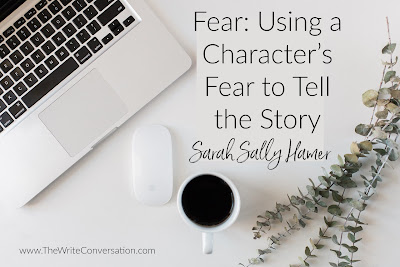by Sarah Sally Hamer @SarahSallyHamer
Most characters, like most humans, have something they’re afraid of. Fear is an amazing driving force and the act of overcoming fear creates an even more amazing character arc.
Dorothy in The Wizard of Oz was out of control at the beginning of the story—Toto was going to be put down because he was “a vicious dog”, Dorothy has to follow rules she doesn’t understand or believe in, and she had to undertake a difficult journey to get home. But, during that journey, even through her very valid fear, she learns that only she has control of her life and she makes that last, fateful sacrifice—to save Toto instead of going home without him. She was terrified throughout most of the story, but she found the courage and strength to make the right choices. And she got to go home.
In Monsters Inc, Sully was afraid of two things—human children and not having enough electricity to power his world. Boo (the cutest cartoon kid I’ve ever seen!) shows him that children are not the monsters Sully and Mike had been taught they were, so Sully has to make a horrible choice: to save his world or save the children. But he learned enough during the story to realize that he could actually save both.
One of the best character arcs I’ve seen in a movie is in Finding Nemo. (Yes, I watch too many animated movies, but I love them!) Marlin is terrified that something bad will happen to his only son, Nemo, and will never let Nemo out of his sight. But Nemo goes off to school one day and is kidnapped by a tropical fish seller. Marlin has to overcome his additional fear of the “big, bad ocean” to find and rescue his child. He confronts sharks in recovery, a blue fish with a ten-second-long memory, and the sea turtles who happily live in “the flow”. But he finds his son. Once he and Nemo are reunited, Nemo once again shows his independent spirit and takes off. Marlin not only allows it, he encourages it, proving that he’s learned his lesson and can allow Nemo his freedom.
This system works so well, it’s a staple in the animated movie world, and is easily translated to any type of fiction. But first, you have to determine what it is that your protagonist fears.
There are as many fears as there are characters, so it may take a little soul-searching on the author’s part to uncover that fear, but it’s always there.
It could be the fear of losing something, like a loved one or money or even the character’s own life.
It could be a fear of finding something, like information that will change the character’s life (who is my real father?) or that the person he or she loves is cheating.
It could be a fear of not being strong or brave or resourceful enough.
All of these things can work. There are thousands more.
So, to apply this information in the story itself starts with a goal. What does your character want? We’ll call her Sue. Let’s say Sue needs to find enough money to pay for her mother’s operation (VERY much a cliché, but easy to understand) because her mother will die without it. Her journey to achieve this goal is fraught with danger, whether real or not. Sue will make decisions throughout the book, based on the fear that she will not be able to save her mom, and learn a lesson from all of the wrong turns she makes.
Eventually, Sue can find a way to get the money. But it comes with consequences. Maybe she has to “sell her soul” by marrying someone she doesn’t love or by stealing or by harming someone else—is her mom’s life worth her own soul? This is where the fear becomes the driving force. Here is what she has most feared—that she won’t be able to help her mom. What choice will she make? Then, how will she live with that choice?
Bottom line: The character arc is about character growth. Sue starts the book with a goal that she can’t achieve. The journey is about the education she needs to achieve that goal. And the Black Moment (at the end of the story) is where the thing she’s most afraid of will happen and she makes a choice based on what she’s learned. In stories with happy endings, it is almost a choice that benefits the protagonist. Other types of endings may not be happy. The movie, Gladiator, comes to mind, where Maximus dies to achieve his goal. He’s not afraid of death, but that he might die before he saves the empire.
So, what is it that your character fears? What will they do to overcome it?
TWEETABLE
Fear: Using a Character’s Fear to Tell the Story, insight from @SarahSallyHamer on @EdieMelson (Click to Tweet)
Sarah (Sally) Hamer, B.S., MLA, is a lover of books, a teacher of writers, and a believer in a good story. Most of all, she is eternally fascinated by people and how they 'tick'. She’s passionate about helping people tell their own stories, whether through fiction or through memoir. Writing in many genres - mystery, science fiction, fantasy, romance, medieval history, non-fiction—she has won awards at both local and national levels, including two Golden Heart finals.
A teacher of memoir, beginning and advanced creative fiction writing, and screenwriting at Louisiana State University in Shreveport for almost twenty years, she also teaches online for Margie Lawson at WWW.MARGIELAWSON.COM. Sally is a free-lance editor and book coach at Touch Not the Cat Books, with many of her students and clients becoming successful, award-winning authors.
You can find her at hamerse@bellsouth.net or WWW.SALLYHAMER.BLOGSPOT.COM


No comments:
Post a Comment